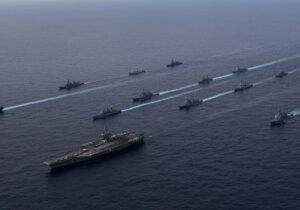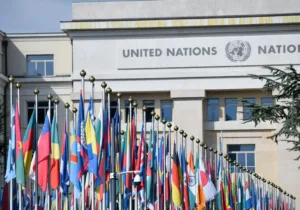In The Strategy of Denial: American Defense in an Age of Great Power Conflict, Elbridge Colby makes an important contribution to the general debate about prioritization in US foreign policy, and to the China-Taiwan issue specifically, if only because his argument is so clearly and powerfully stated that it will facilitate debate. He correctly argues that Asia is the world’s most pivotal region, that preventing Chinese hegemony in Asia is in the US national interest, and that Chinese military victory in Asia would shift the global balance of power away from the US. That said, Colby’s plea for a strategy of denial is abstract to the degree that it leaves crucial issues related to a US defense unaddressed, potentially undermining the search for a practical defense against Chinese aggression.
Colby argues that because US-China relations have entered a “Thucydides Trap,” the US must devise a strategy rooted in collective defense to counter Chinese aggression against its neighbors. Although Colby discusses Taiwanese contingencies, he maintains that a Chinese attack might be aimed at another nearby state (Vietnam, the Philippines), where a collective defense scenario would be more applicable. This east-Asian alliance would be achieved by assembling a coalition of states to defeat Beijing’s strategy, which (according to Colby) is keeping Asian states divided for the purpose of enacting a ‘focused and sequential strategy’ to destroy their enemies piecemeal. All states conceivably threatened by Beijing, whatever their ideological bent, should be included in the coalition if they can effectively contribute to defeating or deterring a Chinese attack.
Although Colby does not exactly specify countries for inclusion in the “anti-hegemonic coalition,” he supports the ‘Quad’ (US, Japan, India, Australia) and draws the coalition’s defensive perimeter to include the ‘first island chain’ (Japan, Taiwan, Philippines) and South Korea. The coalition would function as a collective defense organization that, if attacked, would seek to fight a limited war to parry the main Chinese thrust while avoiding “horizontal escalation,” nuclear war, or extensive collateral damage. Crucial to the coalition’s success is the achievement of achieving air and sea dominance in all conceivable geographic areas which China might attack. Should the coalition fail to repel a Chinese invasion, it should be prepared to interdict Chinese logistics, support insurgent forces, and, ultimately, drive the invaders out of the target state or into the sea.
As stated above, Colby’s analysis provides a well-structured depiction of an abstract Chinese military thrust against an adjacent state or an island in near seas and a corresponding US led collective defense to counter it. However, his conception is rooted 1) in questionable assumptions regarding Chinese intentions and 2) a willingness of potential Asian allies to participate, all the while conspicuously avoiding any discussion of prospects for local US air and naval dominance.
Colby often relies on comparisons to 20th century Europe and Japan’s Pacific war to make his points, but this may do more to confuse than elucidate the issue, as his discussion of coalition and counter-coalition implies that Beijing is seeking to partner with or militarily subdue any number of its neighbors, whereas Beijing only claims a desire to re-integrate the “renegade province” of Taiwan. While prevarication in foreign policy (or, domestic policy, according to Beijing in this case) statements is anything but rare, China has historical and societal ties to Taiwan in ways that it does not regarding other states in East Asia. From Beijing’s standpoint, Taiwan’s separate status is a painful repudiation of Confucian unity and a glaring reminder that the Chinese civil war remains unresolved. Likewise, there is much greater potential for 5th column activity on Taiwan, a factor that was not nearly as relevant to the 20th century conflicts and stand-offs Colby references.
Regarding other Asian countries, while Beijing has constantly increased its military capabilities over the past two decades, it has also launched significant economic interdependence schemes such as the Belt and Road Initiative (BRI). Rather than recruiting military allies or militarily invading Asian neighbors (other than Taiwan), Beijing may merely prefer they remain neutral, persuading them with economic carrots and sticks. Some Asian states will be more amenable to this tactic than others, but to assume that all will rally to prevent a Chinese invasion of Taiwan in NATO-esque Cold War fashion is quite a stretch.
Finally, unlike the Nazis, Bolsheviks, or Imperial Japanese, Beijing is not intending broad military conquest but instead has specifically tailored its military procurement and strategy to defeat America in a Taiwan War. The People’s Liberation Army (PLA) has not attempted to match the US weapon for weapon, but has built an arsenal dedicated to ‘anti-access area denial’ (A2AD) consisting of massive numbers of anti-ship (both cruise and ballistic) and anti-aircraft missiles. Furthermore, even if the US could transfer most of its naval and air forces to the Indo-pacific (now dispersed across the globe), these are currently inadequate to the task of peer competition according to some experts.
Obviously, US adoption of a formal defense denial strategy involving Asian collective security spells the abandonment of the current US policy, strategic ambiguity. A policy reversal that pointedly focuses on preventing a Chinese attack could provoke that very attack before Taiwan is ready (if ever) to withstand it. There is little question that the US should have done more while it possessed a greater military advantage, but “Statesmen always face the dilemma that, when their scope for action is the greatest, they have a minimum of knowledge.”1
However, one can argue that current and former US ignorance was largely voluntary, as self-absorption produced an abiding faith in the forces of history to democratize the world and technological advancement to abolish national differences. The unnecessary Iraq adventure, the attempt to integrate too much untested technology onto US ships, the general faith in “the end of history”—all these grew out of American cultural hubris, and there may yet be a heavy price to pay. As Reinhold Niebuhr reminds us, “every choice is limited by the stuff which nature and previous history present to the hour of decision,” and while the US still has some breadth of action to prevent a Chinese military success, the scope is much narrower than it might have been. As it stands, the US must seek intensive cooperation only with those states that would suffer directly (Japan) from a Chinese attack on Taiwan, and move rapidly to construct an “anti-navy” (a large number of inexpensive, expendable, light surface ships and diesel submarines) as proposed by James Holmes. Instead of adopting European style collective security, as Colby recommends, the US must correct the mistakes it has made in the 21st century, while maintaining strategic ambiguity in the near term.
1 Kissinger, Henry. Diplomacy, (Simon & Schuster, 1995), p294.






 Sponsor a student for Christianity & National Security 2024
Sponsor a student for Christianity & National Security 2024